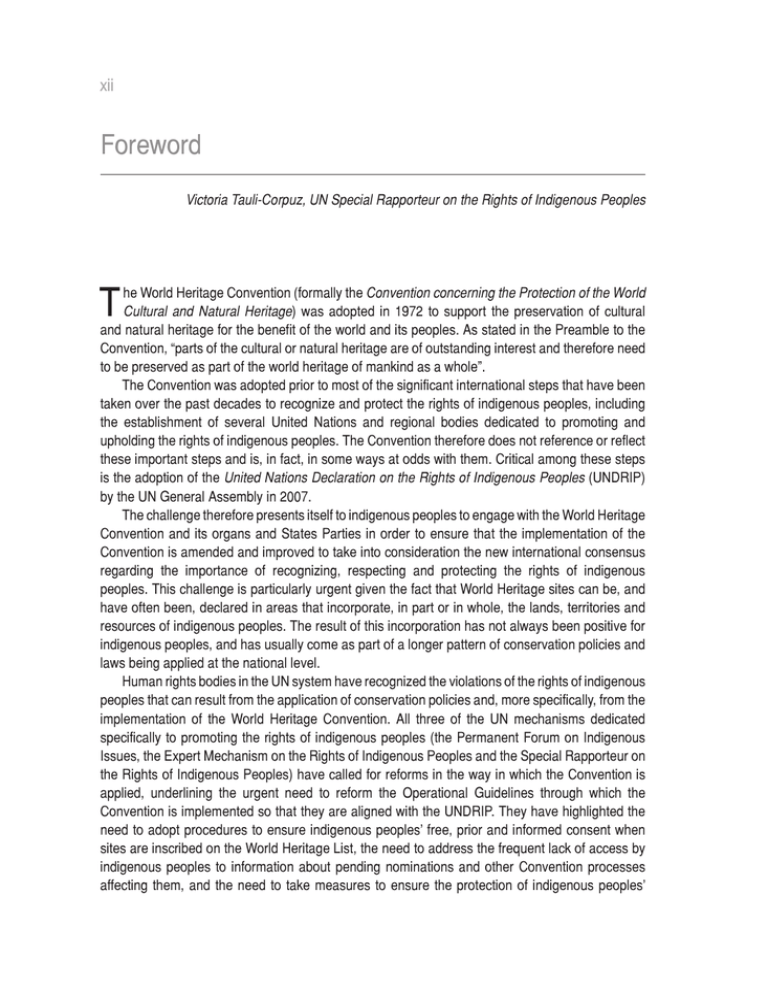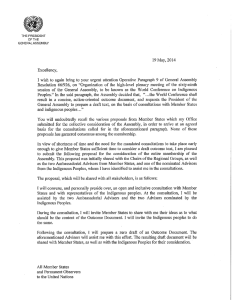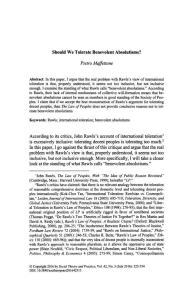Foreword by VickyTauli-Corpuz
Anuncio

xii WORLD HERITAGE SITES AND INDIGENOUS PEOPLES’ RIGHTS Foreword Victoria Tauli-Corpuz, UN Special Rapporteur on the Rights of Indigenous Peoples T he World Heritage Convention (formally the Convention concerning the Protection of the World Cultural and Natural Heritage) was adopted in 1972 to support the preservation of cultural and natural heritage for the benefit of the world and its peoples. As stated in the Preamble to the Convention, “parts of the cultural or natural heritage are of outstanding interest and therefore need to be preserved as part of the world heritage of mankind as a whole”. The Convention was adopted prior to most of the significant international steps that have been taken over the past decades to recognize and protect the rights of indigenous peoples, including the establishment of several United Nations and regional bodies dedicated to promoting and upholding the rights of indigenous peoples. The Convention therefore does not reference or reflect these important steps and is, in fact, in some ways at odds with them. Critical among these steps is the adoption of the United Nations Declaration on the Rights of Indigenous Peoples (UNDRIP) by the UN General Assembly in 2007. The challenge therefore presents itself to indigenous peoples to engage with the World Heritage Convention and its organs and States Parties in order to ensure that the implementation of the Convention is amended and improved to take into consideration the new international consensus regarding the importance of recognizing, respecting and protecting the rights of indigenous peoples. This challenge is particularly urgent given the fact that World Heritage sites can be, and have often been, declared in areas that incorporate, in part or in whole, the lands, territories and resources of indigenous peoples. The result of this incorporation has not always been positive for indigenous peoples, and has usually come as part of a longer pattern of conservation policies and laws being applied at the national level. Human rights bodies in the UN system have recognized the violations of the rights of indigenous peoples that can result from the application of conservation policies and, more specifically, from the implementation of the World Heritage Convention. All three of the UN mechanisms dedicated specifically to promoting the rights of indigenous peoples (the Permanent Forum on Indigenous Issues, the Expert Mechanism on the Rights of Indigenous Peoples and the Special Rapporteur on the Rights of Indigenous Peoples) have called for reforms in the way in which the Convention is applied, underlining the urgent need to reform the Operational Guidelines through which the Convention is implemented so that they are aligned with the UNDRIP. They have highlighted the need to adopt procedures to ensure indigenous peoples’ free, prior and informed consent when sites are inscribed on the World Heritage List, the need to address the frequent lack of access by indigenous peoples to information about pending nominations and other Convention processes affecting them, and the need to take measures to ensure the protection of indigenous peoples’ FOREWORD xiii livelihoods and tangible and intangible cultural heritage in World Heritage areas, among many other issues. My predecessor as Special Rapporteur, James Anaya, dedicated a whole section of his 2012 report to the UN General Assembly to the recurring issue of the impact of World Heritage sites on indigenous peoples, which contains a range of observations and recommendations on measures to prevent and remedy violations of indigenous rights in the implementation of the World Heritage Convention. Additional recommendations are contained in a communication he sent to the World Heritage Centre on 18 November 2013. I intend to follow-up these recommendations during the course of my mandate as Special Rapporteur. It is clear that there is widespread recognition among human rights bodies of the legacy of problems in the implementation of the World Heritage Convention and the impacts that this has had on indigenous peoples. I therefore want to add my support to an important 2012 recommendation of the UN Expert Mechanism on the Rights of Indigenous Peoples, which states: “The Expert Mechanism… encourages the World Heritage Committee to establish a process to elaborate, with the full and effective participation of indigenous peoples, changes to the current procedures and operational guidelines and other appropriate measures to ensure that the implementation of the World Heritage Convention is consistent with the United Nations Declaration on the Rights of Indigenous Peoples and that indigenous peoples can effectively participate in the World Heritage Convention’s decision-making processes.” The members of the Expert Mechanism highlighted both the importance of the UN Declaration on the Rights of Indigenous Peoples as a guide in implementing other conventions or treaties, and the importance of full and effective participation of indigenous peoples in decision-making that affects them, both themes that are explored at length in this book and which are fundamental to empowering indigenous peoples to guide their own development. This book provides detailed case studies exploring the history and continued development and management of World Heritage sites that incorporate, in whole or in part, the lands, territories and resources of indigenous peoples. The testimonies and histories recorded in this book reveal some of the key challenges facing States and the World Heritage Convention bodies in ensuring that the implementation of the Convention does, in fact, support the aspirations of indigenous peoples to see their rights recognized and respected. The testimonies also reveal the hard work done by indigenous peoples in fighting for respect for their rights in World Heritage areas, through direct advocacy with the World Heritage Committee, engagement with international and/or regional human rights bodies, and national level efforts to achieve self-determination over their lands, territories and resources and their economic, social and cultural development as distinct peoples. The stories contained herein reflect both the potential for the World Heritage Convention to support the self-determined development of indigenous peoples by helping them to prevent negative developments in their territories, and the difficulties inherent in the implementation of a Convention that does not explicitly recognize the rights of the peoples on which it has a direct impact. I hope that this book will form a contribution to increasing the respect between the World Heritage Convention and the rights of the indigenous peoples living in or around the natural, cultural and mixed sites protected under the Convention. xiv WORLD HERITAGE SITES AND INDIGENOUS PEOPLES’ RIGHTS In accordance with Human Rights Council resolution 15/14 of 2010, core aspects of my mandate as Special Rapporteur are examining ways and means of overcoming existing obstacles to the full and effective protection of the rights of indigenous peoples; formulating recommendations and proposals on appropriate measures and activities to prevent and remedy violations of the rights of indigenous peoples; and developing a regular cooperative dialogue with all relevant actors, including Governments, relevant United Nations bodies, specialized agencies and programmes. As Special Rapporteur, I look forward to engaging with all the agencies and bodies involved in the implementation of the World Heritage Convention to improve its record with indigenous peoples, and to supporting indigenous peoples in the protection of their own heritage.

